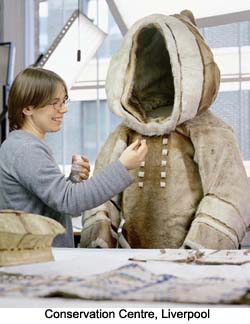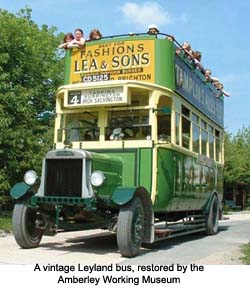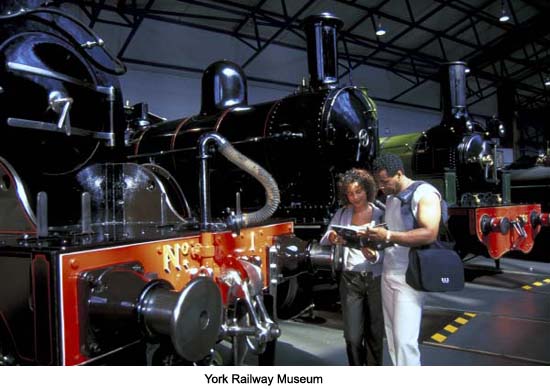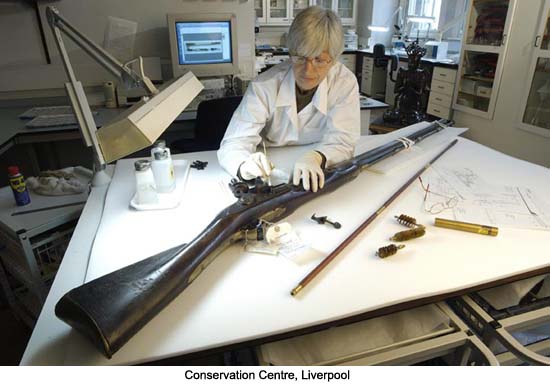Seeing Conservation in Action
by Louise Simmons
 As things get older, they start to deteriorate. It
happens to all of us, but it's a major concern for the keepers of
museums, galleries and archaeological sites, where exhibits are
hundreds or even thousands of years old. Ancient artefacts have
to be preserved, but this must be done sympathetically to
maintain the integrity of each item. While it might be easier to
lock artefacts away in a sealed, climate-controlled, dark room,to
keep them from further degeneration, that's not much help when
the main purpose is to let people see them. So teams of
conservation specialists work to restore and preserve items, from
paintings and books to steam engines and monuments. It's a
fascinating process, and one that we can watch in action
throughout Britain. As things get older, they start to deteriorate. It
happens to all of us, but it's a major concern for the keepers of
museums, galleries and archaeological sites, where exhibits are
hundreds or even thousands of years old. Ancient artefacts have
to be preserved, but this must be done sympathetically to
maintain the integrity of each item. While it might be easier to
lock artefacts away in a sealed, climate-controlled, dark room,to
keep them from further degeneration, that's not much help when
the main purpose is to let people see them. So teams of
conservation specialists work to restore and preserve items, from
paintings and books to steam engines and monuments. It's a
fascinating process, and one that we can watch in action
throughout Britain.
To see conservation in action, one of the foremost places to
visit is at National Museums Liverpool. Founded in 1851, it's
actually made up of eight museums and galleries throughout
Liverpool. The newest of these, opened in 1996, is the
Conservation Centre, housed in an appropriately enough restored
Victorian warehouse.
In the late 1980s, the Liverpool museums found that over half of
their one million exhibits were in need of repair, restoration
and conservation. The Conservation Centre was formed to do this,
but, unlike many other museums, where this work is done behind
the scenes, at Liverpool the emphasis is on letting people see
what's going on. Hands-on workshops are run most weekends, where
you can learn some of the conservators' skills for yourself,
while regular tours let you see how some of the priceless
artefacts are maintained. Everything from taxidermy to laser
cleaning is handled by the people who work here; you'll see them
restoring ceramics, textiles, metalwork, jewellery, sculptures,
paintings and even ships.
 For a more political
viewpoint, why not visit The People's History Museum in
Manchester? Formerly the National Museum of Labour History, the
museum has only been around since the 1970s, but has grown to
become the national centre for the collection and study of
material related to the history of Britain's working classes. It
has the largest collection in the world of historic trade union
banners, including the oldest trade union banner in the world,
that of the Liverpool Tinplate Workers, from 1821.
Unsurprisingly, its Textile Conservation Studio is the UK's
leading authority on the conservation of banners. For a more political
viewpoint, why not visit The People's History Museum in
Manchester? Formerly the National Museum of Labour History, the
museum has only been around since the 1970s, but has grown to
become the national centre for the collection and study of
material related to the history of Britain's working classes. It
has the largest collection in the world of historic trade union
banners, including the oldest trade union banner in the world,
that of the Liverpool Tinplate Workers, from 1821.
Unsurprisingly, its Textile Conservation Studio is the UK's
leading authority on the conservation of banners.
The Conservation Department at the Victoria and Albert Museum in
London employs about 50 people to care for the museum's thousands
of exhibits. Behind-the-scenes tours and talks by conservators on
on-going projects and techniques are offered throughout the year:
email bookings.office@vam.ac.uk to find out what's
on.
Amberley Working Museum, in West Sussex, is an open-air museum
dedicated to the industrial heritage of the southeast of England.
It aims to keep history alive, and as such, has resident
craftspeople who use traditional skills to restore and preserve
the exhibits. Potters, wheelwrights and woodturners show visitors
how things used to be done. One of this year's major projects is
to restore a 1918 steam locomotive engine.
Steam engines have many romantic associations, and are a popular
attraction with grown-ups and children alike. Another great place
to see them in their glory, and learn how they are looked after,
is York's National Railway Museum. As well as all the exhibits
and interactive activities, you can visit The Workshop, where you
can see and talk to the engineers who are restoring some of the
magnificent vehicles owned by the museum.

In a similar vein, there's the Imperial War Museum at Duxford, in
Cambridgeshire, which is itself located on a heritage site: an
airfield used in the First and Second World Wars. It is now one
of Europe's best aviation museums. In addition to its many
exhibitions (it plays host to the famous Air Shows throughout the
year), the museum plays a significant part in the restoration and
conservation of aircraft. This is carried out in some of the many
hangars on the site, and nearly all the work is carried out where
visitors can watch; indeed, the museum reports of many visitors
who return often over a period of time to see how their favourite
plane is coming along.
For a change from museum visits, English Heritage's Festival of
History at Kelmarsh Hall in Northamptonshire in August is well
worth a visit. As well as historic performances, battle
re-enactments, and traditional markets, the weekend event will
include historical lectures, and demonstrations of ancient skills
and crafts.

If you fancy a go at some conservation techniques yourself, or
just want to learn more about some aspect from the experts, there
are a variety of workshops, courses and seminars you can attend.
The Building Conservation website, for instance, has a
comprehensive listing of events, from lectures on historic
joinery and practical sessions on antique furniture restoration
to courses on the conservation and repair of stonework.
All too often at museums we only get to see a finished artefact
once it's been painstakingly restored and put back on show. But
the work involved in that restoration is itself a fascinating mix
of art and science, and it's well worth visiting some of these
places where you can see it as a work in progress.
More Information:
We regret that we no longer have the resources to maintain up-to-date links and/or hours and pricing details for the various sites and attractions listed on this website. For more information about the location(s) listed above, please use your favorite search engine or visit Wikipedia.
Louise Simmons is a Scottish freelance writer who lives in a 19th century farmhouse on the top of a hill in the middle of a sheep-farming area of central Scotland. An engineer by profession, after spending many years working in the IT industry in such unusual places as Nigeria, Russia and various oil rigs in the middle of the North Sea, she decided to take up her favourite occupation, writing, on a full-time basis, and currently writes for several online and print magazines. She particularly enjoys researching and writing about the history and culture of British people and places.
Article © 2006 Louise Simmons
Photos courtesy of National Museums Liverpool Conservation Centre, Amberley Working Museum, and York Railway Museum.
|
